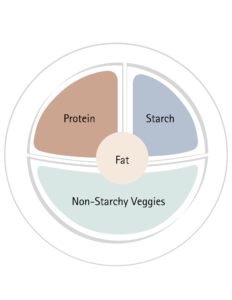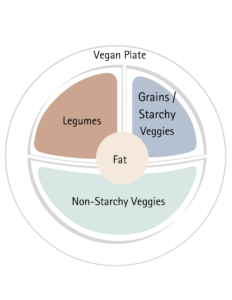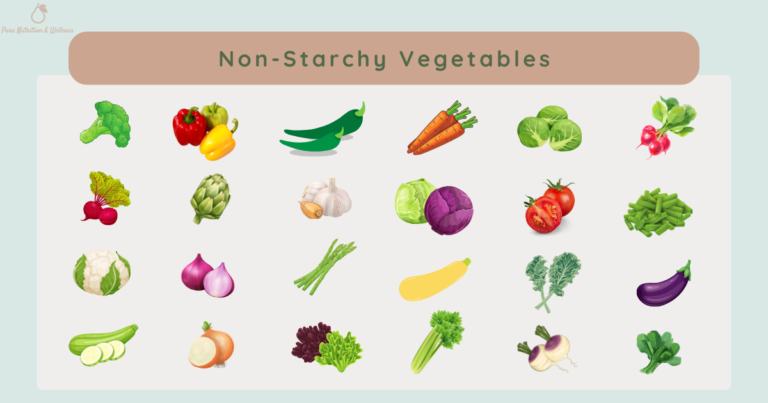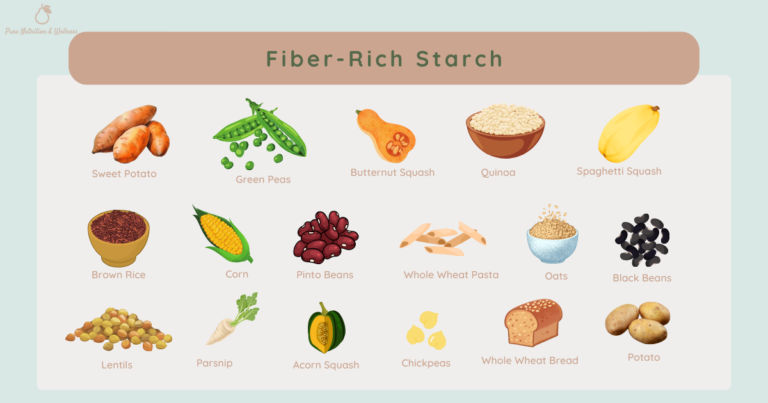Building a balanced plate. . . this skill is foundational to nourishing your body well. It’s an easy nutrition strategy and doesn’t require counting calories or weighing food. Eating with balance allows you to meet your nutritional needs while limiting both blood sugar spikes and between meal cravings. The balanced plate framework is helpful for managing diabetes, losing weight and promoting overall health and wellness.
What is a balanced plate?
A balanced plate contains at least these 4 components:
- Non-starchy vegetables
- Protein
- Starch
- Healthy Fat


How to build a balanced plate.
1. 2 Servings of Non-starchy Vegetables (NSV’s)
Fill half your plate with non-starchy vegetables. The visual reference of a sectioned plate isn’t as straightforward when you are eating from a bowl or eating a casserole-style meal, so in that case, you will need to estimate. You want about half the food you eat to be NSV’s. If your casserole-style meal doesn’t have enough non-starchy veggies to constitute about ½ the food on your plate, consider adding a side vegetable like a small salad. The beauty of using the balanced plate framework is that there is no measuring involved- you are just eyeballing it. It doesn’t have to be perfect or exact.
Both starchy and non-starchy vegetables have health benefits and together fulfill the daily recommended vegetable quota needed to maintain optimal health. The main difference between non-starchy and starchy vegetables is obvious- their starch content. Starch is a complex carbohydrate that is broken down into glucose (blood sugar) and serves as an energy source for cells. Starchy vegetables contain more carbs (starch) and are higher in calories than non-starchy vegetables. In contrast, non-starchy vegetables contain very little starch and are low in calories. Both are nutrient dense, nourishing, and loaded with fiber, vitamins and minerals.
Using the balanced plate framework, first focus on filling half your plate with non-starchy vegetables, and we’ll explore starchy vegetables later.

2. Add Lean Protein
Protein is one of the most important components of a balanced meal for two reasons:
- It keeps you satiated
- It lessens blood sugar spikes
Protein also provides building blocks that are used in the repair and maintenance of body tissue, allows for muscle recovery and growth, functions in the immune system and is involved in regulating every chemical reaction that takes place in the body.
The balanced plate method provides a framework to estimate the amount of protein you need to maintain health. You want about ¼ of your plate to contain lean protein or if you’re vegan, you want to make sure that you are pairing complementary plant-based protein options to supply all the amino acids your body needs. We all have different protein needs based on our age, health, activity level and goals, and if you want to learn more about calculating your protein needs, check out this post.
3. Add A Fiber-rich Starch
Starchy foods are essential for providing short-term energy and providing satiation during your meal. Not all starch choices are created equal though and while some starch choices are fiber-rich and nutrient dense, others (highly processed and refined starchy foods like cookies, white pasta, white bread, etc.) are high in calories and low in vitamins, minerals and fiber. This doesn’t mean that you should never eat processed or refined foods on your balanced plate, but it’s best to choose fiber-filled starchy foods like starchy vegetables, whole grains, beans, and lentils most of the time. There’s often confusion between starchy and non-starchy vegetables. Some common starchy vegetables include green peas, corn, potatoes, sweet potatoes, parsnips, butternut squash, acorn squash and spaghetti squash, and these veggies count for the “starch” portion of your balanced plate, not as the non-starchy vegetable.

4. Include Healthy Fat
Incorporate fat into your meal. This could include putting nuts or seeds on your salad, sauteing your vegetable in extra virgin olive oil, buttering your noodles, or serving avocados on a taco. Healthy fats are essential in our diets and provide energy, satiation, allow us to absorb fat soluble vitamins (A,D,K and E), add flavor to foods, balance hormones, have anti-inflammatory properties, and support brain and nervous system health. Focus on heart-healthy unsaturated fats like extra virgin olive oil, avocado oil, olives, avocados, nuts and seeds.
Fruits
You may have noticed that the balanced plate framework does not include fruits. Fruits should absolutely be included in your balanced eating plan, but are not required at every meal. Fruits are high in fiber, phytonutrients, vitamins and minerals, and most people benefit from eating at least two servings of fruit per day. Because fruits have a naturally high sugar content, they are best paired with protein to minimize blood sugar spikes while still reaping the multitude of health benefits fruit offers.
How to use the balanced plate framework:
The balanced plate framework is not a hard and fast rule that you must follow to the T, but more like a guide to help you plan nourishing, well-balanced meals. To maintain appropriate portion sizes, consider using a 9-inch plate rather than the typical 12-inch dinner plate and visualize your plate in sections as you add food.
The balanced plate framework can be paired with the hand portioning method to estimate portion sizes. In general, a healthy balanced plate will contain:
- roughly two fist-sized portions of non-starchy vegetables (this will likely take up half a 9-inch plate)
- one or two cupped handfuls of fiber-filled starch (¼ of a 9-inch plate)
- one or two palm-sized portions of protein (¼ a 9-inch plate).
- one or two thumb-sized servings of fat included in one or more components of your meal (extra virgin olive oil on roasted veggies, nuts in a salad, etc.)
Using visuals like the balanced plate method or hand portioning method makes it easy to estimate portion size and create healthy, well-balanced meals. If you’re looking for more specific recommendations, consider reaching out to Pure Nutrition and Wellness or a dietitian who can set custom macros or provide other tailored recommendations to meet your fitness and wellness goals!

